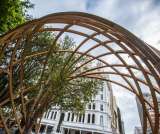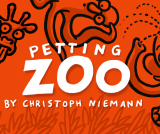
The cast of speakers who take the stage at Design Indaba each year always present a range of unique positions on creativity, but a natural theme tends to emerge from among their respective processes. This year the common idea on everyone's minds is that of the narrative—from food to scent there seems to be an infinite number of ways to artistically tell a story. Below are four standouts that touched upon this concept at Indaba.
Once cheekily called a "seal fucker" by his peers, Noma head chef René Redzepi has changed the way people view his work over the past few years, opening people up to the true beauty of Nordic cuisine. Redzepi talks about using ingredients as "letters" to create a language that weaves a narrative through food. "Why be happy with just A, B and C?" he asks, obsessively foraging and experimenting in order to build new stories that express his vision on a plate. The innovative chef explained to the Indaba audience that he purposely keeps his warehouse-turned-restaurant slightly barren and painted a muted earthy color so the food can really speak to the few lucky diners who get the chance to eat there each evening.
Taking her sense of smell beyond its emotional ties, Norwegian sensory linguist Sissel Tolaas travels the world capturing scents as an effective way to communicate a location, object or time. Part chemist, part artist, Tolaas' wild approach to odors is founded in abstract molecules, which she uses to develop smell codes that then convey a certain meaning when released. The Berlin-based artist works from her SMELL RE_searchLab, where she has more than 2,500 molecules from projects like dissecting David Beckham's shoes—which are exactly on par with an extremely stinky cheese—or recreating the scent of World War I. Tolaas experiments with aromas because, she says, one's sense of smell packs an even greater impact than vision, which creates a memorable connection and relays an inexpressible description.
Filmmaker Chris Milk is interested in creating narrative music videos that can somehow match the emotional relevance of the song they depict. Presenting at Indaba with his frequent collaborator, digital artist Aaron Koblin, Milk produces visual stories that not only coincide with the feeling of a particular track, but are themselves poignant and deeply memorable. His concept for the Johnny Cash song "Ain't No Grave"—an interactive and communal art project—or the Arcade Fire song "The Wilderness Downtown"—an HTML5-built interactive video that allows you to customize your experience to your own address—reiterate his mission to give people a personalized experience which enables their own narrative around the song.
Fascinated by the amount of time people put into making a product, Eindhoven-based furniture designer Piet Hein Eek skips the design stage and starts off in production. Though he cites practical reasons—"labor costs nothing, material costs a fortune"—his method of building from scraps is a conceptual move as well. According to Hein Eek, the remnants lay a foundation for a chair's story more purely than would his own stylistic vision. Therefore, benches are determined by the size of their beams and chairs are covered in fabric found around the derelict buildings near his studio. The names of pieces like the "99.13% cupboard" or "96.7% cupboard" reflect the amount of materials that were not wasted in their production. Hein Eek's transparent design and simple approach give furniture a personalized narrative that its future owner can continue to build upon.















